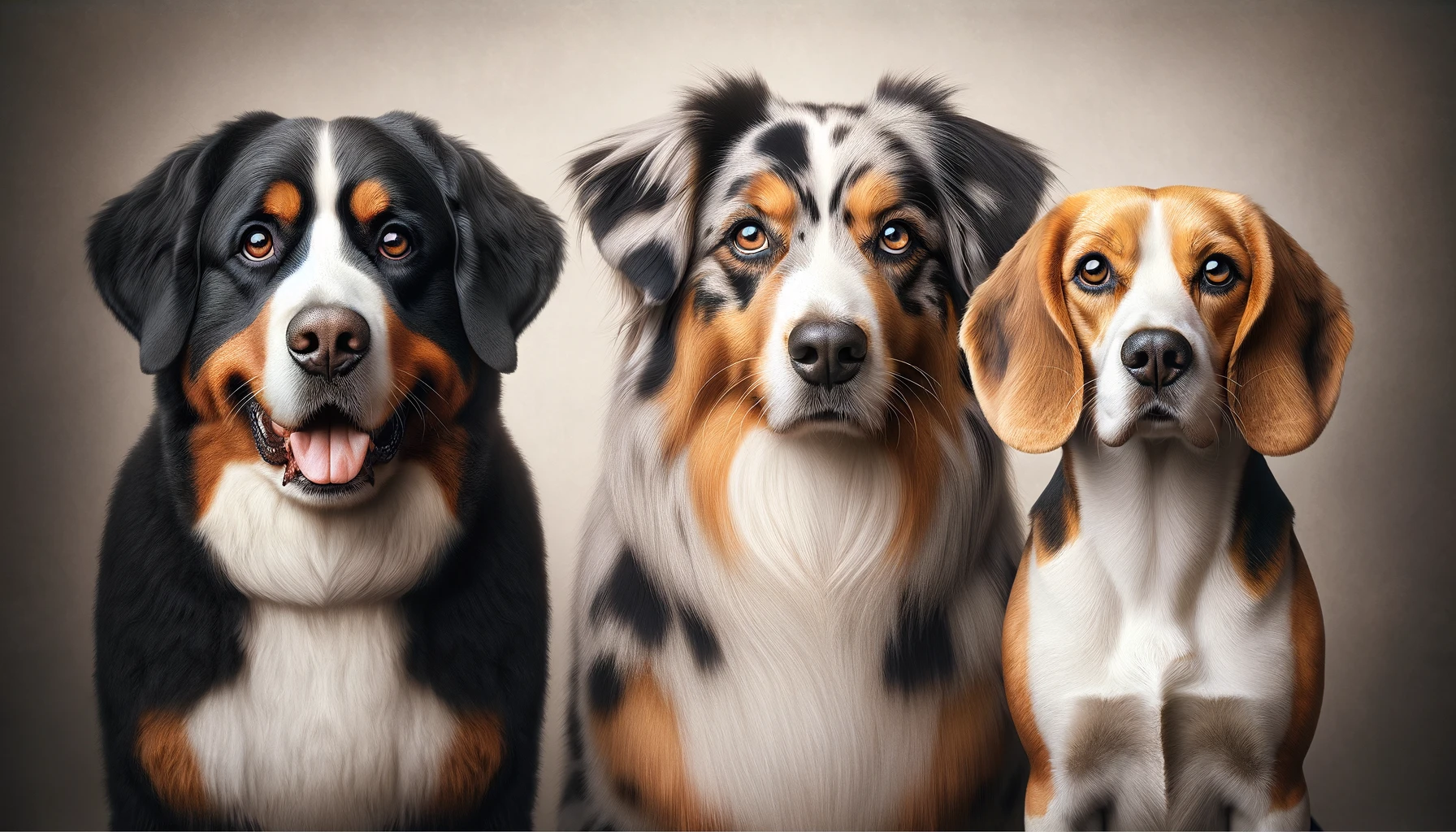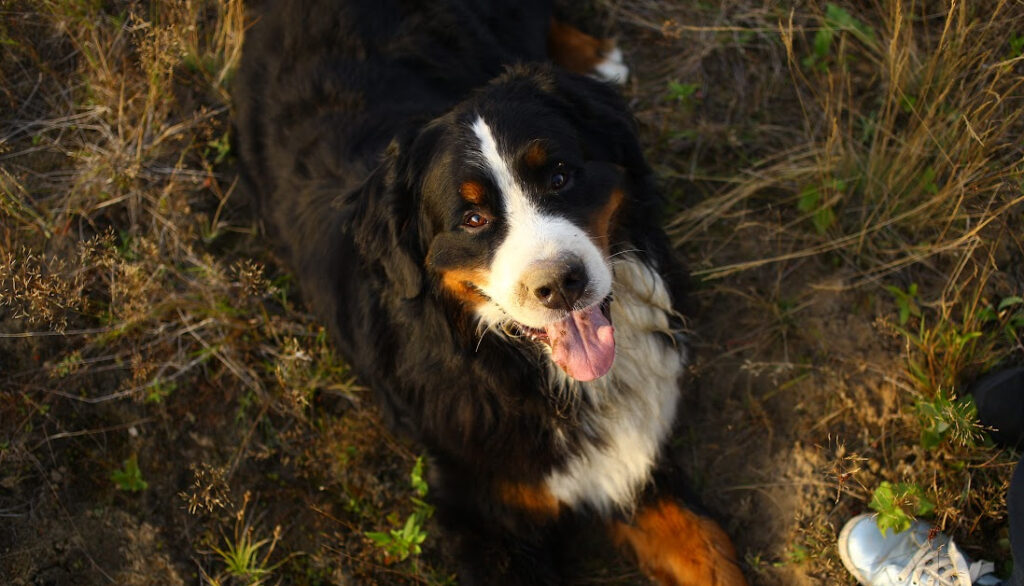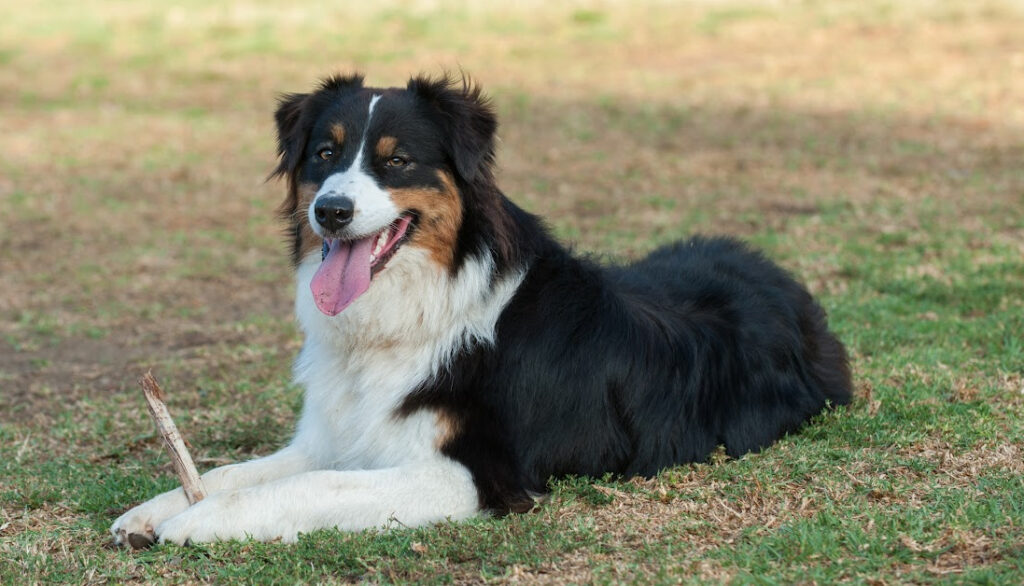As a holistic veterinarian and fellow dog parent, I am excited to dive into the topic of black, white, and brown dog breeds, often referred to as the classic tri-colored canines. There’s something remarkably appealing about these multi-colored dogs, with their captivating coat patterns and lovely blend of hues. Tri-coloration adds a unique visual flair and character to a dog that can be both endearing and majestic. But have you ever wondered why some dogs have this distinctive tri-color fur and what it signifies in different breeds?

Coat color in dogs is far more than just an aesthetic feature. It’s a reflection of their genetics. The combination of black, white, and brown in a dog’s coat is the result of a delicate dance of genes and their respective alleles. As we delve into the genetics of tri-coloration, we will explore how these genes interact to create this beautiful color pattern.
Temperament and breed-specific characteristics also play a significant role in determining whether a certain tri-colored breed might be a good fit for your family and lifestyle. Whether you’re a first-time dog owner or a seasoned canine companion, there’s a wealth of information to consider when choosing the right breed.
From their starring roles in popular culture to the latest breeding trends, tri-colored dogs are indeed fascinating. As we explore this topic together, I hope to provide you insights into the world of black, white, and brown dog breeds, their unique quirks and qualities, and how to best care for them. This is your guide to the colorful world of tri-colored canines, a celebration of their diversity, beauty, and charm. So, let’s embark on this journey together to explore the classic, the unique, and the downright adorable in the world of black, white, and brown dog breeds.
The Genetics Behind Tri-Coloration in Dogs
Ever wondered why your furry friend has that charming blend of black, white, and brown hues? That captivating tricolor coat that makes everyone turn their heads is no random occurrence; it’s a testament to the wonders of canine genetics. This section will take you on an exciting journey to unravel the genetic makeup that gives birth to the enigmatic tri-colored canines. It’s like CSI, but for your pooch!
How Genetics Determine Dog Coat Colors
The color of a dog’s coat is determined by two factors: pigment type and pigment distribution. The pigment type can be either eumelanin (which produces black or brown color) or pheomelanin (which results in yellow or red color). The distribution of these pigments across a dog’s coat is decided by their genes.
Simplifying it further, consider these two pigments as paint, and the genes as an artist deciding where and how much of each paint to use. The interplay of these genes and pigments results in a variety of coat colors and patterns in dogs, including the beautiful tri-coloration of black, white, and brown.
Common Gene Combinations for Black, White, and Brown Dogs
Tri-colored dogs’ coats are majorly a combination of two base colors, black and white, with patches of brown (also known as tan or liver). The most common gene combination responsible for this tri-coloration is the interaction of Agouti (A) gene and K (dominant black) gene. Let’s break it down:
- The Agouti gene (A) controls the distribution of black and yellow pigments on dogs. If the Agouti gene codes for tan points (at), it results in areas of tan coloring on the cheeks, eyebrows, chest, legs, and under the tail.
- The K gene controls whether the eumelanin pigment will be expressed or not. If a dog carries the dominant form (KB), it causes the coat to be solid black or brown. However, if combined with at from the Agouti gene, it allows the tan points to show, giving us a classic tri-colored appearance.
So there you have it, the genetic cocktail for our beloved black white and brown dog breeds. The process might sound a bit complex, but the beauty it creates is undoubtedly simple to appreciate!
Remember, while genetics play a significant role, other factors like diet, age, and exposure to sunlight can also affect a dog’s coat color. So, ensure your tri-colored pooch is well taken care of to maintain their vibrant coat.

Popular Tri-Colored Dog Breeds
For those who have a penchant for diversity, tri-colored dogs, specifically black, white, and brown dog breeds, offer a beautiful blend of shades. Here are some of the most popular small and large tri-colored breeds.
Small Breed Examples
Beagle: Known for their black saddles, white underbellies, and brown heads, Beagles are one of the most recognized tri-colored breeds. They’re known for their friendly personalities and exceptional sense of smell.
Cavalier King Charles Spaniel: Often seen with patches of black, white, and brown, these little dogs are a perfect blend of elegance and charm.
Boston Terrier: While they’re primarily black and white, some Boston Terriers have a brownish tint in their coat. These energetic and friendly pups have a tuxedo-like appearance that’s hard to resist.
Dachshund: Dachshunds come in various patterns and colors, including the distinct tri-coloration of black, white, and brown. Their unique body shape adds even more appeal to their stunning coats.
Large Breed Examples
Bernese Mountain Dog: Known for their striking black, white, and brown coats, these gentle giants are as beautiful as they are loyal.
Australian Shepherd: Despite their name, these dogs actually originated in the United States. Their coats are often a beautiful blend of black, white, and brown colors, making them stand out in a crowd.
Border Collie: Famous for their intelligence and agility, Border Collies often have a black and white coat with brown spots. Their expressive eyes add to their overall charm.
Greater Swiss Mountain Dog: Much like their Bernese counterparts, these dogs have thick, tri-colored coats that need regular grooming to maintain their beauty.
Each of these black, white, and brown dog breeds has a unique blend of colors that enhances their overall appearance. However, keep in mind that a dog’s coat color does not determine their behavior or suitability for your lifestyle. It’s essential to consider a dog’s personality, needs, and breed-specific characteristics when choosing a pet.
Caring for Tri-Colored Dog Breeds
Grooming Needs for Multi-Colored Coats
Taking care of a black, white, and brown dog breed requires a bit more attention, particularly when it comes to grooming. These tri-colored canines often have different types of fur textures within their coat, demanding tailored grooming regimes.
- Brushing: Regular brushing is important to maintain the health and shine of their coat. Brushes that can reach the undercoat are essential for breeds with thick fur, like the Bernese Mountain Dog. Small breeds with softer coats, like the Papillon, may benefit from softer brushes.
- Bathing: While bathing schedules depend on the breed and the dog’s lifestyle, a general rule is to bathe your tri-colored dog once a month. However, dogs with certain skin conditions may require more frequent baths with medicated shampoos.
- Trimming: Some tri-colored dog breeds have fast-growing hair that may require regular trimming. This includes the hair around their eyes, ears, and paws.
Health Considerations Specific to Tri-Colored Dogs
While the color of a dog’s coat doesn’t directly relate to their health, it’s important to note that some black, white, and brown dog breeds may be prone to specific health issues.
- Beagle: These small tri-colored dogs are at risk of obesity, hypothyroidism, and epilepsy.
- Bernese Mountain Dog: They are prone to certain cancers, hip and elbow dysplasia, and heart diseases.
- English Setter: This breed often suffers from hip dysplasia, deafness, and thyroid problems.
Proactive healthcare is crucial for these breeds. Regular vet check-ups and keeping up-to-date with vaccinations and preventative medications is a must. Additionally, a balanced diet and regular exercise play an essential role in maintaining your dog’s overall health.
It’s important to remember that each dog is unique and not every pet will develop these health issues. However, being aware of these potential risks can help you spot any early signs and seek appropriate medical attention, ensuring your tri-colored canine companion leads a happy, healthy life.
Grooming and healthcare are instrumental in caring for black, white, and brown dog breeds. Regular grooming not only keeps your tri-colored dog looking their best but also provides an opportunity to check for any abnormalities, like lumps or skin issues. As for health, being aware of breed-specific risks and proactive healthcare can significantly contribute to ensuring a high quality of life for your pet.

Training and Temperament of Tri-Colored Dogs
Behavioral Traits in Tri-Colored Breeds
When it comes to the temperament of black, white, and brown dog breeds, it’s crucial to remember that behavior is influenced more by breed and upbringing than by coat color. That said, there are some general observations we can make about these tricolored canines.
Many tri-colored breeds, like the Beagle, Bernese Mountain Dog, and Australian Shepherd, are known for their friendly and sociable nature. These dogs tend to be good with families, including children and other pets. They’re often outgoing and enjoy being part of the family’s activities.
On the other hand, some breeds, like the Border Collie and the Shetland Sheepdog, are known for their intelligence and work ethic. These dogs may require more mental stimulation and exercise to keep them happy and well-behaved.
Here are a few typical traits found in some popular tri-colored breeds:
- Beagles: Friendly, curious, and great with kids.
- Bernese Mountain Dogs: Gentle, affectionate, and good-natured.
- Australian Shepherds: Intelligent, active, and work-oriented.
- Border Collies: Extremely smart, energetic, and require mental stimulation.
- Shetland Sheepdogs: Intelligent, eager to please, and highly trainable.
Training Tips for Tri-Colored Canines
Training any dog breed, including those with black, white, and brown coats, should be based on positive reinforcement methods. Here are some tips that can help you train your tri-colored furry friend effectively:
- Start Early: Begin training your dog as soon as possible. Puppies are more receptive to learning new commands and behaviors.
- Be Consistent: Consistency is key in dog training. Ensure all family members use the same commands and reward system.
- Use Positive Reinforcement: Reward your dog for good behavior with treats, praise, or playtime. This encourages them to repeat the behavior.
- Patience is Key: Training takes time. Be patient and never resort to punishment or negative reinforcement.
- Consider Professional Help: If you’re struggling with training, consider seeking help from a professional dog trainer.
Remember, every dog is unique, and their temperament can vary even within the same breed. When choosing a black, white, and brown dog breed, consider your lifestyle and what you want in a canine companion. With the right training and socialization, these tri-colored beauties can make wonderful, loving pets.
Tri-Colored Dog Breeds in Popular Culture
Famous Tri-Colored Dogs in Media
When you think of tri-colored dogs in popular culture, several famous pooches may come to mind. Lassie, the Rough Collie from the classic film, was a beautiful example of a black, white, and brown dog breed. With her sable and white coat interspersed with black tips, she is one of the most iconic canine characters of all time.
Another well-known black, white, and brown dog is Snoopy from the comic strip Peanuts. While primarily black and white, Snoopy is often depicted with a brown spot on his back in some of the animated adaptations. His breed, the Beagle, is commonly found in this tri-colored combination.
Lady, from Disney’s “Lady and the Tramp,” is a beautiful depiction of a tri-colored American Cocker Spaniel showing a blend of black, white, and brown markings.
The Role of Coat Color in Dog Breed Popularity
Coat color plays a significant role in a dog breed’s popularity. People often choose their pets based on aesthetic appeal, and a dog’s fur color can significantly influence this decision. Many mixed breeds and pure breeds alike come in the eye-catching combination of black, white, and brown fur.
For instance, Bernese Mountain Dogs, with their distinct black, white, and brown markings, have gained immense popularity partially because of their striking appearance. Similarly, Cavalier King Charles Spaniels, known for their black, brown, and white fur, are loved for their adorable looks and are often seen in films and TV shows.
It’s essential to remember, though, that while a dog’s coat color might be captivating, it’s their temperament, health, and compatibility with your lifestyle that truly matter when choosing a furry friend. Whether they’re starring on the silver screen or simply being the star of your home, black, white, and brown dog breeds certainly have a special place in our hearts and our culture.
In conclusion, just as humans are captivated by the unique beauty of tri-colored dog breeds, so too is popular culture. From beloved comic strip characters to iconic film and TV dogs, these breeds have made a significant impact. Their striking coat colors not only contribute to their popularity but also endear them to dog lovers worldwide. Despite their fame, it’s important to remember that every dog, regardless of their coat color, deserves a loving and caring home.

Choosing the Right Tri-Colored Dog for Your Family
Opting for a black white and brown dog breed is a delightful choice, as these tri-colored canines are not just striking in appearance but often come with unique personality traits and characteristics. But, the question is – how do you choose the right one for your family? Here are some factors to consider.
Matching Dog Breeds to Lifestyle
When choosing a dog breed, it’s crucial to consider your lifestyle. Every breed has its own specific needs in terms of physical activity, mental stimulation, and care.
For instance, the Bernese Mountain Dog, a popular black, white, and brown dog breed, is known for its calm disposition but also needs a good amount of exercise due to its working-dog heritage. If you have an active lifestyle and a spacious living environment, a breed like this could be ideal.
On the other hand, the tri-colored Basset Hound is more laid-back and can adapt well to apartment living with moderate exercise needs. If you’re more of a homebody, a low-energy breed may be a better match.
Consider the following when aligning breed characteristics with your lifestyle:
- Physical Activity Levels
- Space Requirements
- Temperament
- Care and Grooming Needs
Considerations for First-Time Dog Owners
If you’re a first-time dog owner, choosing a black, white, and brown dog breed involves some additional considerations. Some breeds can be more challenging to train and care for than others, particularly for novices.
Firstly, take into account the breed’s trainability. Breeds like the Border Collie, known for their black, white, and brown coats, are highly trainable, but also require an owner that can match their high energy levels and challenge them mentally.
Secondly, consider the grooming needs. Tri-colored dogs can have a variety of coat types, from the short-haired Beagle to the long-haired Cavalier King Charles Spaniel, and this significantly impacts the time and effort required for grooming.
Lastly, look at the breed’s health predispositions. While individual health can vary widely within a breed, it’s important to be aware of common conditions in the breed to ensure you’re prepared for potential care and costs.
To sum up, choosing a black, white, and brown dog breed should be a decision based on an understanding of the breed and a realistic assessment of your lifestyle and capabilities. Every dog deserves a loving home where it fits in and feels comfortable, and every owner deserves a dog that brings joy, companionship, and the least amount of stress possible.
The Future of Tri-Colored Dog Breeds
Trends in Breeding and Coat Colors
In the intriguing world of black, white, and brown dog breeds, trends are ever-evolving. As our understanding of genetics deepens, we’re witnessing an increasing interest in breeding dogs with unique coat colors, including the appealing tri-coloration.
For breeders, the challenge lies in creating the perfect balance of black, white, and brown fur while maintaining the breed’s inherent characteristics and health. Advances in genetic research are enabling breeders to predict coat color outcomes with greater accuracy, leading to a rise in the popularity of tri-colored breeds. A trend we see rising is the desire for dogs with distinct, well-defined color patches, often known as ‘color blocking.’
However, it’s not just about aesthetics. The health of these dogs remains paramount. Responsible breeders are striving to ensure that the quest for the perfect coat doesn’t compromise the overall health and vitality of the dog.
Conservation of Rare Tri-Colored Breeds
While some tri-colored breeds are becoming increasingly popular, others are sadly becoming less common. Breeds such as the Otterhound and the English Foxhound are seeing a decline in their numbers, thus increasing the need for conservation efforts.
Preservation of these rare tri-colored breeds is crucial to maintaining the rich diversity of the canine world. Organizations worldwide are making concerted efforts to protect these breeds. They do this through a combination of responsible breeding programs, public education about these breeds, and fostering a community of breed enthusiasts who can ensure their survival.
So, how does this impact you, a potential dog parent? Well, choosing a rare tri-colored breed not only gives you a unique companion but also contributes to the conservation of the breed.
As we look to the future, I can’t help but feel excited about what it holds for black, white, and brown dog breeds. With the rise of genetic research, the dedication of breeders, and the love of dog owners like you and me, we’re set to see incredible progress in the world of tri-colored canines.
Before I sign off, remember, owning a dog is a big responsibility. It’s not just about the dog’s appearance but also their health, temperament, and suitability to your lifestyle. So, when you’re choosing your four-legged friend, take your time, do your research, and make an informed decision.
Here’s to the joy and companionship that our beloved black, white, and brown dog breeds bring to our lives. And here’s to their future – a future that is as bright and diverse as their gorgeous coats.
Frequently Asked Questions
Q1: What are some common tri-colored dog breeds?
A1: Some common tri-colored dog breeds include the Bernese Mountain Dog, the Basset Hound, and the Beagle.
Q2: Are tri-colored dogs more prone to any specific health issues?
A2: The color of a dog’s coat does not typically have any impact on their health. However, certain breeds, regardless of color, may be more prone to specific health issues.
Q3: Does the color of a dog’s coat affect its behavior or temperament?
A3: No, the color of a dog’s coat does not affect its behavior or temperament. These traits are determined by a combination of genetics and upbringing.
Q4: How can I maintain the coat of my tri-colored dog?
A4: Regular grooming is essential for maintaining the coat of any dog. This includes regular brushing to remove loose hairs and prevent matting, as well as regular baths to keep the coat clean and healthy.
Q5: Are tri-colored dogs rare?
A5: The rarity of tri-colored dogs can depend on the breed. Some breeds commonly have tri-colored coats, while others do not.
Dr. Candy, a holistic veterinarian and certified raw dog food nutrition specialist, graduated from Oklahoma State University in 2009 with a DVM and has since specialized in companion animal nutrition, advocating for species-specific diets. With a background in wildlife rehabilitation and oil spill response, she combines holistic health and conventional medicine in her unique approach to treating chronic diseases, allergies, and autoimmune conditions in pets. As the owner of a veterinary practice in Colorado and an author, Dr. Candy is dedicated to educating pet parents and improving the health and happiness of animals.




